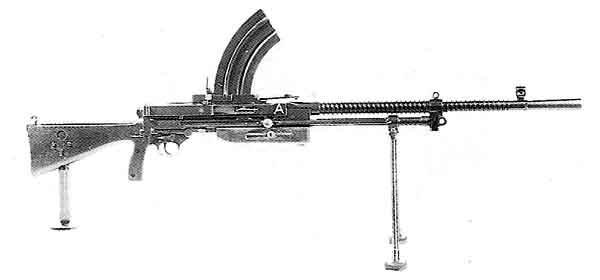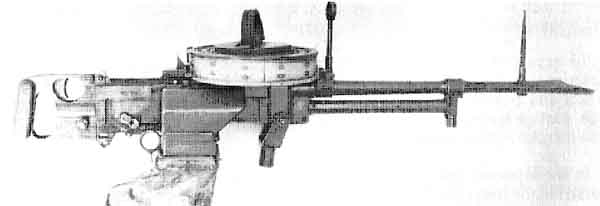A French army officer, Lieutenant Andre (or Adolphe) Berthier, secured Belgian patents for an automatic rifle, or light machine gun (LMG), in 1905. The weapon was considered to be too fragile to meet the demands of service use and Berthier then produced another model to an improved design in 1908.
With a gas-operated mechanism similar to that later employed in Browning’s automatic rifle adopted by the United States as the BAR Model 1918, Berthier’s new design featured a peculiar cooling system, unlike anything ever used on any other weapon. The barrel of the gun was contained within a jacket to which, at either end, was attached a rubber tube connected to a bulb, one of which was filled with water. As the barrel heated, squeezing the bulb containing water propelled the water through the space between the barrel and the jacket into the other bulb. The water could then be squeezed back again as the need for further barrel cooling arose.
Perhaps not surprisingly, Berthier abandoned his unique cooling system and modified the gun to permit the quick exchange of barrels, in much the same manner as with the later ZB and Bren LMGs.
Berthier’s new air-cooled design was not taken up by the French ordnance department, or by anyone else. The French, for reasons known only to themselves, adopted as their light machine gun the Chauchat Modele 1915, a weapon of surpassing inferiority widely condemned as the poorest machine gun taken into service anywhere. Berthier went to the United States in 1916 with the hope of persuading the Americans to buy his gun, or to at least manufacture it. The gun was well received by the United States Army and Marines, and orders were placed, but the 1914-1918 War ended before production commenced.
The British armaments manufacturer Vickers-Armstrong Limited acquired the rights to the weapon in 1924 and produced an improvement on the 1908 model as the Vickers-Berthier. This was demonstrated to the British Small Arms Committee in January 1925 and, apart from minor and easily rectifiable defects, was deemed efficient. Some sales were made to other nations, including Bolivia, in the early 1930s.
The Vickers-Berthier featured as a contender in the extended trials to select a replacement for the Hotchkiss and Lewis light machine guns – trials that became tests for a general-purpose machine gun to replace both LMGs and the Vickers medium machine gun (MMG). In the event, the Vickers remained in service but the trials gave the Vickers-Berthier first place, the Czech ZB26 second, the Danish Madsen third and the BAR fourth as LMG replacements. Trials with the Vickers-Berthier and the ZB26 continued in 1926 until endurance tests showed the obvious superiority of the Czech weapon, which was then developed at the Enfield Royal Small Arms Factory into the redoubtable Bren gun.
However, the Indian Government, which had a large degree of autonomy in the selection and procurement of weapons for the British-Indian army, tired of the prolonged testing and in 1933 adopted the Vickers-Berthier as the force’s LMG. As did the British, the Indian Army relinquished any notion of a general- purpose machine gun for the time being and kept the Vickers in service.

There were five models of the Vickers-Berthier – the original Mark I, the Mark II in two forms and the Mark III, also in two forms. The Indian guns produced at the Ishapore Small Arms Factory were the Mark III and Mark IIIB types.
An entirely adequate weapon, the Vickers-Berthier was well regarded in the Indian service but the employment of Indian formations with the British forces in the North Africa, Italy and Burma campaigns of the 1939-1945 War led to difficulties in spare parts supply and problems in training. The Vickers-Berthier was therefore gradually replaced by the Bren gun as the standard LMG in Indian overseas service. However, the Vickers-Berthier remained in service in India until at least the late 1970s.
In appearance, the Vickers-Berthier and the Bren had a distinct similarity. Both had top-mounted magazines, curved as necessitated by the rimmed .303 inch cartridge. The Vickers-Berthier had at least two types of grip, one similar to the Bren grip and the other resembling a revolver grip in style.
The Vickers-Berthier Mark I had a slab-sided fore-end under the receiver and cooling fins on the barrel. A bipod was attached to the gas cylinder and a monopod was fixed to the butt. The Mark II, introduced in 1929-1930, had a rounded fore-end, the bipod and monopod and was little changed from the Mark I. The Light Mark II, an experimental model produced for the Indian Army in 1931, eliminated the cooling fins and monopod, had a light fore-end and trimmed-down butt. The Mark III, introduced in 1933, was a heavier version of the Light Mark II and the Mark IIIB had an improved gas system. The Marks III and IIIB lacked a fore-end. None of the marks had a rear sight in the style of the excellent aperture drum rear sight that the Bren Mark I inherited from the ZB26 but were equipped with a folding-leaf rear sight similar to the type on later marks of the Bren.
In addition to the Vickers-Berthier LMG, Vickers-Armstrong produced the Vickers ‘K’ or VGO (Vickers Gas Operated) machine gun based on a redesign of the Vickers-Berthier system. The Royal Air Force adopted the VGO as an observer’s gun in twin-seater aircraft pending the general introduction of power-operated turrets in 1941. The limited number of surplus VGOs were then transferred to the army and were issued to special operations units, including the Long Range Desert Group and the Special Air Service. With an initial cyclic rate of fire of 1050 rounds per minute (rpm), later reduced to 950 rpm, as opposed to the 500 rpm of the Bren and the 450-500 rpm of the Vickers-Berthier, the VGO was eminently well suited to the brief but heavy strikes characteristic of such forces. Some VGOs were used in Australian service, both in aircraft and in ground applications.

| Vickers-Berthier Mk.III |
|---|
| Calibre --- .303 inch, rimmed cartridge. |
| Feed system --- 30 round box magazine. |
| Rate of fire --- 450-500 rpm. |
| Muzzle velocity --- 2450fps/745 m/sec. |
| Mass --- 20.72 lb/9.40 kg. |
| Length overall --- 46.50 in/1180 mm. |
| Barrel length --- 23.90 in/607 mm. |
| Vickers 'K' (VGO) |
|---|
| Calibre --- .303 inch rimmed cartridge. |
| Feed System --- 100 round non-rotating magazine. |
| Rate of fire --- 1050 rpm, later reduced to 950 rpm. |
| Muzzle velocity --- 2450 fps/745 m/s. |
| Mass --- 1950 lb/8.86 kg. |
| Length overall --- 40.00 in/1016 mm. |
| Barrel length --- 20.00 in/508 mm. |
Hogg, I.V., The Illustrated Encyclopedia of Firearms, London, New Burlington Books, 1967.
Hogg, I.V. & R. Adam, Jane’s Guns Recognition Guide, Glascow, Harper Collins Publishers, 1996.
Hogg, I.V. & J. Weeks, Military Small Arms of the 20th Century: A Comprehensive Illustrated Encyclopedia of the World’s Small-Calibre Firearms, 6th Edition, London, Arms & Armour, 1991.
Myatt, F., Modern Small Arms, London, Salamander Books, Ltd., 1978.
Skennerton, I.D. 100 Years of Australian Service Machine Guns, Margate, I.D. Skennerton, 1989.